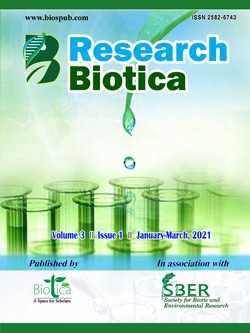
General Studies of Induced Genotoxicity and Oxidative Stress on Horticultural Crops
Chandan Singh Ahirwar*
School of Agriculture, ITM University, Gwalior, Madhya Pradesh (474 001), India
Ravindra Nath
School of Agriculture, ITM University, Gwalior, Madhya Pradesh (474 001), India
DOI: https://doi.org/10.54083/ResBio/3.1.2021.44-46
Keywords: Genotoxicity, Horticulture crops, Importance, In-vitro testing, Oxidative, Stress
Abstract
Genotoxicity is a word in genetics defined as a destructive effect on a cell's genetic material (DNA & RNA) affecting its integrity. Genotoxins are mutagens; they can cause mutations. In genetics, genotoxicity describes the property of chemical agents that damages the genetic information within a cell causing mutations, which may lead to cancer. While genotoxicity is often confused with mutagenicity, all mutagens are genotoxic, whereas not all genotoxic substances are mutagenic. The alteration can have direct or indirect effects on the DNA: the induction of mutations, mistimed event activation, and direct DNA damage leading to mutations. The permanent, heritable changes can affect either somatic cells of the organism or germ cells to be passed on to future generations, the alteration can have direct or indirect effects on the DNA: the induction of mutations, mistimed event activation, and direct DNA damage leading to mutations. The permanent, heritable changes can affect either somatic cells of the organism or germ cells to be passed on to future generations.
Downloads
not found
Reference
Anderson, D., Plewa, M.J., 1998. The international Comet assay workshop. Mutagenesis 13(1), 67-73.
Contrera, J.F., Matthews, E.J., Kruhlak, N.L., Benz, R.D., 2005. In silico screening of chemicals for bacterial mutagenicity using electrotopological E-state indices and MDL QSAR software. Regulatory Toxicology and Pharmacology 43, 313-323.
Evans, H.J., Neary, G.J., Williamson, F.S., 1959. The relative biological efficiency of single doses of fast neutrons and gamma-rays on Vicia faba roots and the effect of oxygen. Part II. Chromosome damage: the production of micronuclei. International Journal of Radiation Biology and Related Studies in Physics, Chemistry and Medicine 1, 216-229.
Fenech, M., Kirsch, V.M., Natarajan, A.T., Surralles, J., Crott, J.W., 2011. Molecular mechanisms of micronucleus, nucleoplasmic bridge and nuclear bud formation in mammalian and human cells. Mutagenesis 26(1), 125-132.
Hanahan, D., Weinberg, R.A., 2011. Hallmarks of cancer: The next generation. Cell 144(5), 646-674. DOI: 10.1016/j.cell.2011.02.013.
Harper, P.S., 2006. The discovery of the human chromosome number in Lund, 1955-1956. Hum Genet 119(1-2), 226-232. DOI: 10.1007/s00439-005-0121-x.
Hartmann, A., Agurell, E., Beevers, C., Brendler, S.S., Burlinson, B., 2003. Recommendations for conducting the in-vivo alkaline comet assay. Mutagenesis 18, 45-51.
Hsiao, S.H., Huang, TH.M., Leu, Y.W., 2009. Excavating relics of DNA methylation changes during the development of neoplasia. Seminars in Cancer Biology 19(3), 198-208. DOI: 10.1016/j.semcancer.2009.02.015.
Huang, Y., Chang, C.C., Trosko, J.E., 1983. Aphidicolin-induced endoreduplication in Chinese hamster cells. Cancer Research 43(3), 1362-1364.
IARC, 2012. Personal habits and indoor combustions. In: IARC Monographs on the Evaluation of Carcinogenic Risks to Humans, Volume 100E. pp. 1-575. Available at: http://publications.iarc.fr/122.
Jackson, M.A., Stack, H.F., Waters, M.D., 1993. The genetic toxicology of putative nongenotoxic carcinogens. Mutation Research 296(3), 241-277. DOI: 10.1016/0165-1110(93)90014-E.
Jones, S., Wang, T.L., Shih, I.M., Mao, T.L., Nakayama, K., Roden, R., 2010. Frequent mutations of chromatin remodeling gene ARID1A in ovarian clear cell carcinoma. Science 330(6001), 228-231. DOI: 10.1126/science.1196333.
Knudson Jr., A.G., 1973. Mutation and human cancer. Advances in Cancer Research 17, 317-352. DOI: 10.1016/S0065-230X(08)60534-5.
Lee, G.Y., Kenny, P.A., Lee, E.H., 2007. Three-dimensional culture models of normal and malignant breast epithelial cells. Nature Methods 4, 359-365.
Legator, M.S., Malling, H.V., 1971. The host-mediated assay, a practical procedure for evaluating potential mutagenic agents in mammals. In: Chemical Mutagens: Principles and Methods for their Detection, Volume 2. (Ed.) Hollaender, A. Plenum Press, New York, USA. pp. 569-89. DOI: 10.1007/978-1-4615-8969-3_12.
Liber, H.L., Thilly, W.G., 1982. Mutation assay at the thymidine kinase locus in diploid human lymphoblasts. Mutation Research 94(2), 467-485.
Lin, Z., Reierstad, S., Huang, C.C, 2007. Novel estrogen receptor-alpha binding sites and estradiol target genes identified by chromatin immunoprecipitation cloning in breast cancer. Cancer Research 67, 5017-5024.
Lindeman, L.C., Vogt-Kielland, L.T., Alestrom, P., 2009. Fish’n ChIPs: chromatin immunoprecipitation in the zebrafish embryo. In: Chromatin Immunoprecipitation Assays. (Ed.) Collas, P. Methods in Molecular Biology, Volume 567. Humana Press, Totowa, NJ. pp. 75-86.
Linney, E., Donerly, S., Mackey, L., 2011. The negative side of retinoic acid receptors. Neurotoxicology and Teratology 33, 631-640.
Lister, R., Pelizzola, M., Dowen, R.H, 2009. Human DNA methylomes at base resolution show widespread epigenomic differences. Nature 462, 315-322.
Locke, H.C., 1983. Endoreduplication in Chinese hamster cells during alpha-radiation induced G2 arrest. Mutation Research 119(3), 403-413.
